
The Order of the Red Banner was the first Soviet military decoration. The Order was established on 16 September 1918, during the Russian Civil War by decree of the All-Russian Central Executive Committee. It was the highest award of Soviet Russia, subsequently the Soviet Union, until the Order of Lenin was established in 1930. Recipients were recognised for extraordinary heroism, dedication, and courage demonstrated on the battlefield. The Order was awarded to individuals as well as to military units, cities, ships, political and social organizations, and state enterprises. In later years, it was also awarded on the twentieth and again on the thirtieth anniversary of military, police, or state security service without requiring participation in combat.

Yevgeny Ananyevich Khaldei was a Soviet Red Army naval officer and photographer. He is best known for his World War II photograph of a Soviet soldier raising a flag over the Reichstag in Berlin, the capital of the vanquished Nazi Germany, at the end of the war.

Kuzma Minin, full name Kuzma Minich Zakhariev-Sukhoruky, was a Russian merchant who, together with Prince Dmitry Pozharsky, formed the popular uprising in Nizhny Novgorod against the Polish–Lithuanian Commonwealth's occupation of Russia during the Polish intervention in Russia (1605-1618) coinciding with the Time of Troubles. The popular uprising ultimately led to Russian victory at the Battle of Moscow and the end of Polish occupation in 1612. Minin and Pozharsky become national heroes in Russian culture and were honored in the Monument to Minin and Pozharsky in Moscow's Red Square.
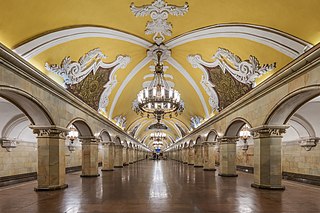
Komsomolskaya is a Moscow Metro station in the Krasnoselsky District, Central Administrative Okrug, Moscow. It is on the Koltsevaya line, between Prospekt Mira and Kurskaya stations.
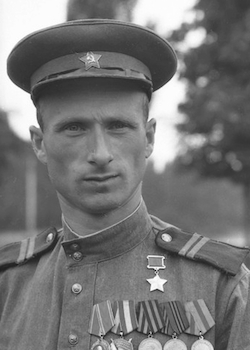
Meliton Varlamis dze Kantaria or Kantariya was a Georgian sergeant of the Soviet Army credited with having hoisted a Soviet flag over the Reichstag on 1 May 1945, together with Mikhail Yegorov and Aleksey Berest.

The Soviet Banner of Victory was the banner raised by the Red Army soldiers on the Reichstag building in Berlin on 1 May 1945, the day after Adolf Hitler committed suicide. It was raised by three Soviet soldiers: Ukrainian Alexei Berest, Russian Mikhail Yegorov, and Georgian Meliton Kantaria.

Raqymjan Qoshqarbaev was the first soldier to raise the Soviet Flag at the Reichstag building in Berlin, having placed the flag by a staircase in the opera hall after sneaking into the building. After nightfall Qoshqarbaev and several of his comrades raised the flag on the roof. However, because they had raised the flag in the night when it was too dark to take a photo, none of them were part of the iconic photo of Soviet soldiers raising the flag on 2 May. After the raising of the flag on 30 April it was shot down by German snipers shortly before the Wehrmacht briefly retook control of the building. However, by 2 May the Soviets retook control of the building and raised the flag again, bringing photographer Yevgeny Khaldei with them to capture a reenactment of the historic moment.
Mikhail Prokofievich Kovalev was a Soviet military officer.
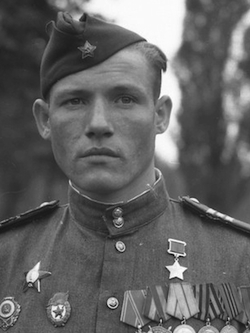
Mikhail Alekseyevich Yegorov, along with Meliton Kantaria and Alexei Berest, was one of the three soldiers credited with raising the Soviet flag over the Reichstag on the 1 May 1945 after the Battle of Berlin.
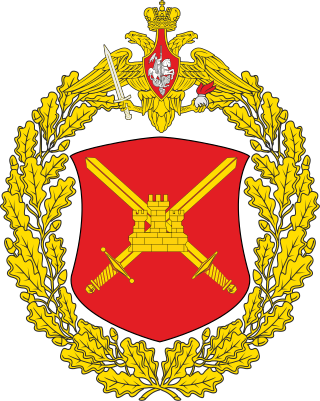
The 150th Guards Motor Rifle Idritsa-Berlin Order of Kutuzov Division of the Russian Ground Forces is a motorized rifle division that was re-instituted in 2016. It is part of the 8th Guards Combined Arms Army, which was reformed in 2017, in the Southern Military District.

Mikhail Yevgenyevich Porechenkov is a Russian film actor, producer, director. He became famous after his lead role as FSB Agent Alexey Nikolayev in the TV series National Security Agent (1999–2005). In 2008, Porechenkov produced, directed and starred in D-Day, a Russian remake of the 1985 American action film Commando.

Mikhail Andreyevich Gluzsky was a Soviet and Russian theater and film actor. He starred in the 1972 film, Monologue, which was entered into the 1973 Cannes Film Festival. An actor in more than 130 films between his film debut 1939 and death in 2001, he was named a People's Artist of the USSR in 1983.
Mikhail Ivanovich Doller was a Soviet film director and screenwriter. He worked as co-director with Vsevolod Pudovkin and was awarded Stalin Prize twice in 1941.

Raising a Flag over the Reichstag is a World War II photograph, taken during the Battle of Berlin on 2 May 1945. It depicts a Soviet soldier raising the flag of the Soviet Union over the Reichstag. The photograph was reprinted in thousands of publications and came to be regarded around the world as one of the most significant and recognizable images of World War II. Owing to the secrecy of Soviet media, the identities of the men in the picture were often disputed, as was that of the photographer, Yevgeny Khaldei. It became a symbol of the Soviet victory over Nazi Germany.
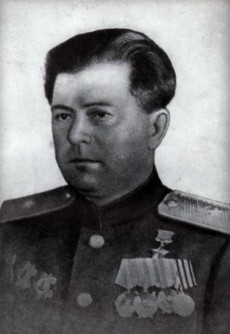
Vasily Mitrofanovich Shatilov was a Soviet Army colonel general who commanded the 150th Rifle Division, credited with the capture of the Reichstag during the Battle of Berlin.
Fedor Matveevich Zinchenko was a Soviet officer who commanded the 150th Rifle Division's 756th Regiment during the Storming of the Reichstag. The soldiers under his command raised the Victory Banner.

Alexei Prokopievich Berest was a Soviet political officer and one of the three Red Army soldiers who hoisted the Victory Banner.
The 33rd Rifle Division was a rifle division of the Red Army and Soviet Army, formed twice. The division was formed in 1922 at Samara and moved to Belarus in the next year. It fought in the Soviet invasion of Poland in September 1939 and in the Occupation of Lithuania in June 1940. After Operation Barbarossa, the division fought in the Baltic Operation and Leningrad Strategic Defensive. In January 1942, it fought in the Toropets–Kholm Offensive. The division participated in the Leningrad–Novgorod Offensive, the Pskov-Ostrov Offensive, the Tartu Offensive and the Riga Offensive. In 1945, the division fought in the East Pomeranian Offensive and the Battle of Berlin. The division remained in Germany postwar with the Soviet occupation forces and disbanded in 1947. In 1955, it was reformed from the 215th Rifle Division in the Far East and inherited that division's honorifics, but was disbanded in 1956.
Minin is a Russian masculine surname, its feminine counterpart is Minina. It may refer to
Gazi Kazykhanovich Zagitov was a participant in the Great Patriotic War, on April 30, 1945, at 22:40, as part of an assault group under the command of Guard Captain V. N. Makov, he plant a Red Banner over the Reichstag building in Berlin. At the same time, Zagitov received a through wound to the chest, but continued the fight. Tatar by nationality.













